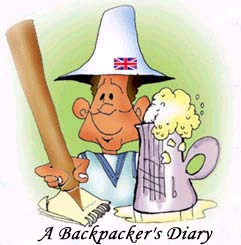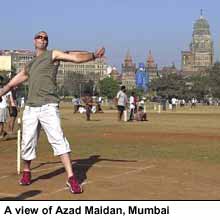 January 10, 2002
January 10, 2002
At Shivaji Park...
- Jonathan Dyson
When, soon after arriving in India, I asked for help with my research into the grassroots of Indian cricket, an overwhelming majority of responses suggested I visit Shivaji Park in Dadar, Mumbai.
Having studied the famous maidans near Churchgate on my last visit to Mumbai, and now having returned here recently after a relaxing week in Goa, my first port of call just had to be this hugely influential park.
Over the last two months I have gradually become aware of the immense significance of this maidan. As Richard Cashman observes in his study of Indian cricket, Patrons, Players and the Crowd, Shivaji Park played a key part in the heartbeat of Mumbai cricket moving in the 1950s from central Mumbai to the northern suburbs of Dadar and Shivaji Park.
As Cashman writes: "The change has occurred because the more affluent youth of Bombay central often chose to pursue other diversions such as social tennis, swimming and the cinema, unlike the inhabitants of Dadar and Shivaji Park who have fewer recreational activities.
"In this new heartland of Bombay cricket there were many incentives to play cricket: Shivaji Park has a large maidan where there is room for many informal and formal games."
That was written in 1979, and there are actually now signs that the "other diversions" to which Cashman refers have grabbed the attention of the Dadar and Shivaji Park youth. There are two tennis courts within the maidan, and several youngsters wander round in basketball, baseball and English football shirts.
However the overwhelming love of cricket is still obvious, and the fact that this has remained the cradle of Mumbai cricket can be seen no more clearly than through the emergence of Sachin Tendulkar and Vinod Kambli, who both famously learnt their craft here.
When I first walked round Shivaji Park it appeared identical to the more celebrated maidans I had seen near Churchgate, covered as it was in the same variety of games, from organised club matches to casual games played in non-white clothing.
However I soon noticed some significant differences. For a start there is no walkway through the middle. This seems to lend an even more intense, frenetic atmosphere - Shivaji Park is clearly used solely for cricket, unlike the maidans, which also see people wander through at their leisure, and sit down to chat on small, grassy areas. There certainly don't seem to be many old ladies in bright saris brave enough to venture through the chaos of Shivaji Park.
 Another clear difference is the way in which some of
the cricket games are separated from each other. On
the maidans, each game takes up a round oval,
admittedly overlapping with others, but it is always
ensured that the game is played within a
cricket-ground-like shape.
Another clear difference is the way in which some of
the cricket games are separated from each other. On
the maidans, each game takes up a round oval,
admittedly overlapping with others, but it is always
ensured that the game is played within a
cricket-ground-like shape.
Contrastingly, on the edges of Shivaji Park are rows of games organised in what can only be described as strips, with just a twenty-two yard pitch used for each one. With batsmen still quite happy to cut and pull at will, the subsequent scampering of fielders from one pitch to the next creates even more chaos than on the Azad Maidan.
However the same diversity of standard, and the same wonderful feeling of anyone who likes playing cricket, at whatever level, being welcome, is undoubtedly present at Shivaji Park. And as Cashman again notes, "possibly the greatest incentive [to succeed is] that young players [can] watch some of the contemporary stars at close quarters." For instance, Sunil Gavaskar played at Shivaji Park, even during his Test match days.
For a while I watched a Times Shield Competition match, and afterwards was introduced to Provident Fund all-rounder Rajesh Naik, who also plays for Goa. He agreed that it was great to see such a wide range of standards exhibited on one maidan. And having played for a club side in England, he also suggested that the English game might benefit from such a set-up.
That youngsters are inspired by the presence of such high-quality players is evidenced by another acquaintance I made on Sunday. I was watching one young player knock about with a friend, when it struck me just how composed he looked, and how sweetly he was timing his shots. An older on-looker quickly informed me that he is in fact the youngest scorer of a triple century in India.
Harsh Tank made 329 not out in 45 overs for Jamnabhai Narsi School in Juhu last November. While Tendulkar was thirteen when he made 327 in schools cricket, Tank was one year younger, and as Tank eagerly pointed out, his ton was made in limited overs cricket, unlike Tendulkar's.
And encircling these current and future stars, who occupy the grassy areas in the centre of the park, there are the youths who play round the edges, on the dusty soil, constantly driving the ball as hard as they can, and scurrying between the wickets like their lives depend on it, invariably in bare feet or loose slippers.
I played in such a game early in the morning with a group of lads of a similar age to me. Thankfully I found myself in a more relaxed game than some of the more impassioned contests, which can be found almost everywhere. My teammates told me that they just play for fun each Sunday, using cricket as a break from their work or studies.
It is easy to why Shivaji Park has given birth to so many stars. The intense love of cricket, the willingness to learn, the accessibility that means anyone with a bat and a ball can turn up and play, all make it an ideal learning ground for any cricketer. Suddenly the quiet, laidback field in Yorkshire where I learnt the game pales into embarrassing insignificance.
GE Features
©1996 to 2001 rediff.com India Limited. All Rights Reserved.